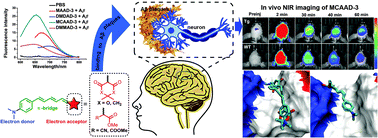Evaluation of molecules based on the electron donor–acceptor architecture as near-infrared β-amyloidal-targeting probes†
Abstract
A novel class of near-infrared molecules based on the donor–acceptor architecture were synthesized and evaluated as Aβ imaging probes. In vivo imaging studies suggested that MCAAD-3 could penetrate the blood–brain barrier and label Aβ plaques in the brains of transgenic mice. Computational studies could reproduce the experimental trends well.


 Please wait while we load your content...
Please wait while we load your content...